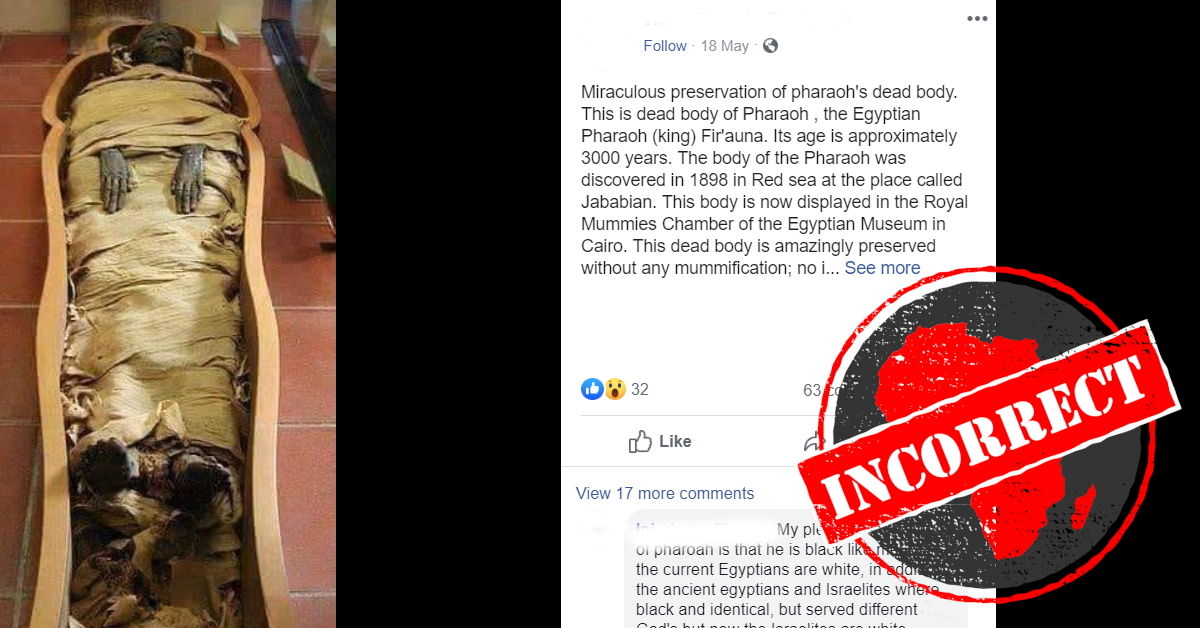Does a photo show the body of an ancient Egyptian pharaoh called “Fir'auna”, miraculously preserved without any mummification despite being “inside the sea for more than 3000 years”? No, but that’s the claim in a post published on Facebook in Nigeria in May 2019.
The post shows a body wrapped in brown fabric inside a wooden sarcophagus.
Its text reads: “Miraculous preservation of pharaoh's dead body. This is the dead body of... the Egyptian Pharaoh (king) Fir'auna. Its age is approximately 3000 years... This body is now displayed in... the Egyptian Museum in Cairo.
“This dead body is amazingly preserved without any mummification; no inside organs have been removed... Phoroah's body was inside the sea for more than 3000years. Fish in the sea could have easily eaten the flesh, but they didn't.”
The post goes on to say that Fir'auna (it also calls him “Fia'aun” and “Firaun”) was a “cruel king” who “denied the existence of God Almighty”, so “Allah made him drown in the Red Sea and Allah preserved his body over 3000 years without any mummification”.

A reverse image search brings up a similar photo of the body, on the website Impressive. The photo shows a mummy of a woman – not a king – dated at 1070 to 945 BCE and found in Thebes, an ancient Egyptian city on the Nile river some 800 kilometres south of the Mediterranean sea.
The mummy is held at the Vatican Museum in Rome, Italy.
So, no. The photo doesn’t show a king – it’s a woman. The body has been mummified – not “miraculously preserved”. It was found on dry land, and is in a museum in Rome, not the Egyptian capital of Cairo. – Africa Check (31/05/19)
The post shows a body wrapped in brown fabric inside a wooden sarcophagus.
Its text reads: “Miraculous preservation of pharaoh's dead body. This is the dead body of... the Egyptian Pharaoh (king) Fir'auna. Its age is approximately 3000 years... This body is now displayed in... the Egyptian Museum in Cairo.
“This dead body is amazingly preserved without any mummification; no inside organs have been removed... Phoroah's body was inside the sea for more than 3000years. Fish in the sea could have easily eaten the flesh, but they didn't.”
The post goes on to say that Fir'auna (it also calls him “Fia'aun” and “Firaun”) was a “cruel king” who “denied the existence of God Almighty”, so “Allah made him drown in the Red Sea and Allah preserved his body over 3000 years without any mummification”.

Mummified woman found in Thebes
A reverse image search brings up a similar photo of the body, on the website Impressive. The photo shows a mummy of a woman – not a king – dated at 1070 to 945 BCE and found in Thebes, an ancient Egyptian city on the Nile river some 800 kilometres south of the Mediterranean sea.
The mummy is held at the Vatican Museum in Rome, Italy.
So, no. The photo doesn’t show a king – it’s a woman. The body has been mummified – not “miraculously preserved”. It was found on dry land, and is in a museum in Rome, not the Egyptian capital of Cairo. – Africa Check (31/05/19)
Republish our content for free
For publishers: what to do if your post is rated false
A fact-checker has rated your Facebook or Instagram post as “false”, “altered”, “partly false” or “missing context”. This could have serious consequences. What do you do?
Click on our guide for the steps you should follow.
Publishers guideAfrica Check teams up with Facebook
Africa Check is a partner in Meta's third-party fact-checking programme to help stop the spread of false information on social media.
The content we rate as “false” will be downgraded on Facebook and Instagram. This means fewer people will see it.
You can also help identify false information on Facebook. This guide explains how.





Add new comment